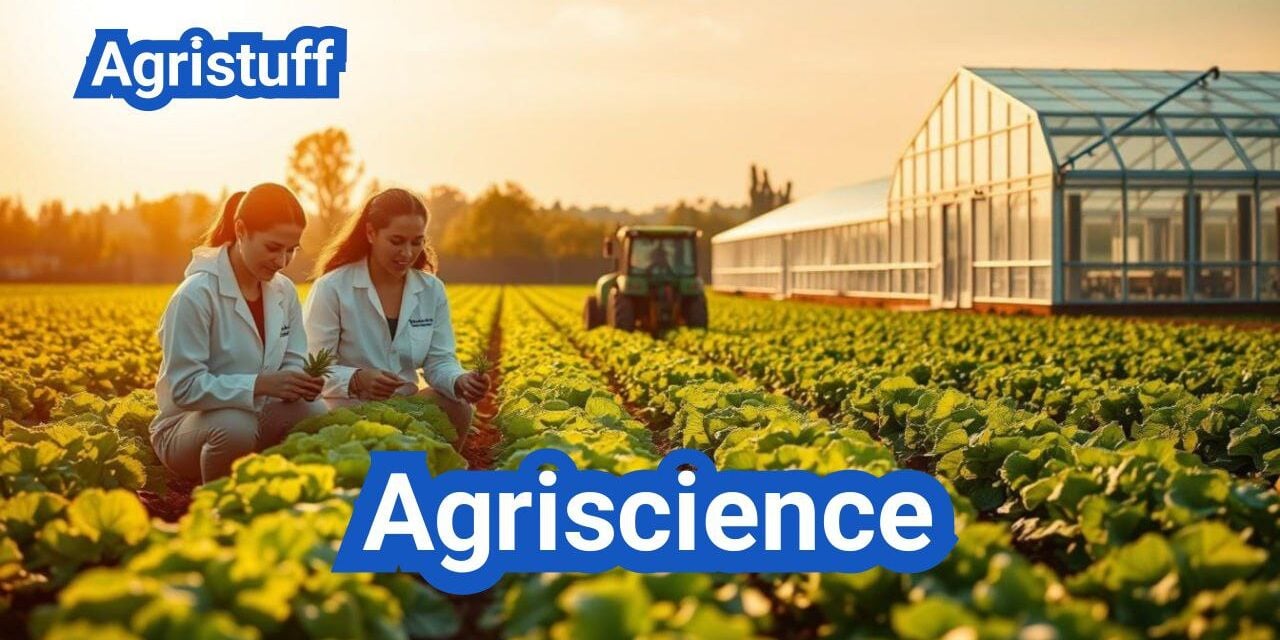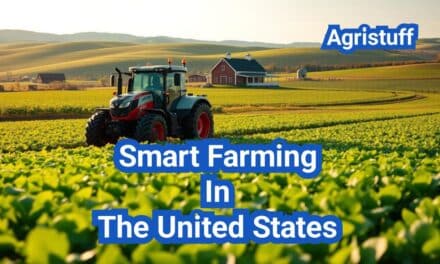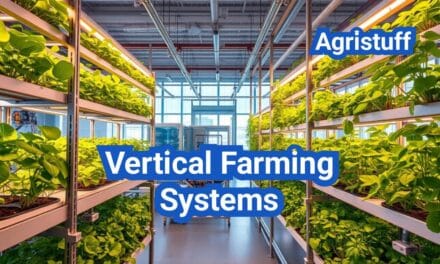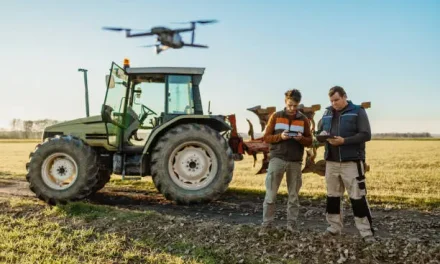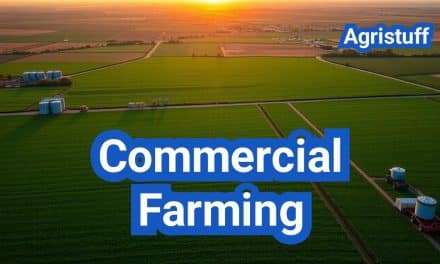Agriscience is a multidisciplinary field that combines agriculture and science to improve crop yields, disease resistance, and nutritional content. The Agricultural Science field is crucial in modern agriculture as it drives innovation and sustainability.
The AgriScience Program, under initiatives like the Sustainable Canadian Agricultural Partnership, supports research and pre-commercial science activities that benefit the agriculture and agri-food sector. By exploring agriscience degrees and careers, individuals can contribute to advancements in agricultural practices and food production.
Key Takeaways
- Agriscience integrates agriculture and science to enhance crop yields and nutritional value.
- The field is vital for driving innovation and sustainability in modern agriculture.
- Agriscience degrees and careers offer opportunities to contribute to agricultural advancements.
- The AgriScience Program supports research and pre-commercial science activities.
- Agriscience has real-world applications in improving agricultural practices and food production.
Understanding Agriscience: The Intersection of Agriculture and Science
The field of agriscience represents a crucial intersection of agriculture and scientific principles. Agriscience applies scientific knowledge to improve agricultural practices, enhancing productivity and sustainability. This interdisciplinary field combines biology, chemistry, physics, and earth science to develop innovative solutions for food production and environmental conservation.
Definition and Core Concepts
Agriscience is defined as the application of scientific principles to agricultural practices. It encompasses a broad range of disciplines, including agricultural biology, soil science, and agricultural engineering. The core concepts of agriscience involve understanding the biological, chemical, and physical processes that underpin agricultural systems.
Key components of agriscience include:
- Crop and animal improvement through genetic research
- Soil health management and conservation
- Precision agriculture technologies
- Pest and disease management strategies
- Environmental impact assessment and mitigation
Companies like Corteva Agriscience are at the forefront of agriscience innovation, developing new products and technologies that improve crop yields and reduce environmental impact. For instance, Corteva Agriscience has been involved in various agricultural innovations, including seed treatments and pest management solutions.
Historical Development of Agriscience
The historical development of agriscience has been shaped by advances in technology, biology, and environmental science. The evolution of agriscience can be traced back to the early 20th century when scientific methods began to be applied to agricultural practices.
| Period | Key Developments | Impact on Agriculture |
|---|---|---|
| Early 20th Century | Introduction of synthetic fertilizers and pesticides | Increased crop yields and reduced labor |
| Mid-20th Century | Development of hybrid crops and irrigation technologies | Improved crop resilience and water management |
| Late 20th Century | Advances in genetic engineering and biotechnology | Enhanced crop traits and pest resistance |
| 21st Century | Precision agriculture and digital farming technologies | Increased efficiency and reduced environmental impact |
As noted by Norman Borlaug, known as the “Father of the Green Revolution,” “Agriculture is the foundation of civilization and any stable economy.” This quote underscores the importance of agriscience in ensuring global food security and sustainable development.
The future of agriscience holds much promise, with ongoing research and innovation aimed at addressing the challenges of climate change, food security, and environmental sustainability. As the field continues to evolve, it is likely to have a profound impact on the way we produce food and manage natural resources.
The Difference Between Agriculture and Agriscience

Agriscience and agriculture, though related, have distinct approaches to farming and food production. While agriculture is the practice of cultivating the soil, growing crops, and raising livestock, agriscience applies scientific principles to improve agricultural practices.
The AgriScience Program supports projects that address priority national themes and horizontal issues in agriculture, exemplifying the scientific approach to agriculture. This program focuses on pre-commercial science activities and research, driving innovation and addressing pressing issues in the sector.
Traditional Agricultural Practices
Traditional agriculture often relies on established methods and techniques passed down through generations. These practices have been effective but may not be optimized for modern challenges such as climate change, soil degradation, and water scarcity.
“The traditional farming practices have been the backbone of agriculture for centuries, but they need to be adapted to meet the demands of a growing population and environmental challenges.”
A comparison of traditional and modern agricultural practices reveals significant differences in approach and outcome. The following table highlights some key differences:
| Aspect | Traditional Agriculture | Agriscience |
|---|---|---|
| Methods | Rely on established techniques | Uses modern technology and research |
| Productivity | Limited by traditional methods | Improved through scientific interventions |
| Sustainability | May not prioritize environmental sustainability | Focuses on sustainable practices |
The Scientific Approach to Agriculture
Agriscience, on the other hand, applies modern scientific knowledge and technology to improve agricultural productivity and sustainability. This approach includes the use of genetic engineering, precision agriculture, and advanced irrigation systems.
The scientific approach to agriculture is not just about increasing yield; it’s also about ensuring sustainability and environmental stewardship. By leveraging technology and research, agriscience can help address some of the most pressing issues in agriculture today.
For instance, precision agriculture allows farmers to optimize crop yields and reduce waste by using data-driven insights. This not only improves productivity but also minimizes the environmental impact of farming practices.
Key Disciplines Within Agriscience
At its core, agriscience is composed of several critical areas of study that are essential for developing sustainable agricultural solutions. These disciplines work together to address the complex challenges facing modern agriculture, from improving crop yields to reducing environmental impact.
Agricultural Biology and Genetics
Agricultural biology and genetics are fundamental to understanding how crops and livestock can be improved through scientific intervention. By studying the genetic makeup of plants and animals, scientists can develop new varieties that are more resilient to disease and environmental stress. Genetic modification and traditional breeding techniques are used to enhance desirable traits, such as drought tolerance or nutritional content.
The application of agricultural biology extends to understanding ecosystems and biodiversity. This knowledge is crucial for maintaining ecological balance and ensuring that agricultural practices are sustainable over the long term.
Soil Science and Environmental Studies
Soil science is another vital discipline within agriscience, focusing on the health and productivity of soil. Soil scientists study the physical, chemical, and biological properties of soil to understand how it supports plant growth and affects the environment. Soil conservation practices, such as reduced tillage and cover cropping, are essential for preventing erosion and maintaining soil fertility.
Environmental studies in agriscience examine the broader ecological context in which agriculture operates. This includes understanding the impact of agricultural practices on water quality, biodiversity, and climate change. By adopting sustainable practices, farmers can reduce their environmental footprint while maintaining productivity.
Agricultural Engineering and Technology
Agricultural engineering and technology play a crucial role in modernizing farming practices. The development of precision agriculture tools, such as GPS-guided equipment and drones, allows farmers to optimize inputs like water and fertilizers, reducing waste and environmental impact. Agricultural engineers also design and implement irrigation systems, farm machinery, and other technologies that improve efficiency and productivity.
The integration of agricultural technology extends to data analysis and decision-making. By leveraging data from various sources, farmers can make informed decisions about planting, harvesting, and crop management, further enhancing the sustainability and profitability of their operations.
Agriscience Education Pathways
Students interested in agriscience have various educational pathways to choose from, ranging from high school programs to advanced degrees. These pathways provide a foundation for careers in the agricultural sector and beyond.
High School Agriscience Programs
High school agriscience programs offer students an introduction to the principles of agriculture and science. These programs often include hands-on experiences such as:
- Supervised Agricultural Experiences (SAE)
- Laboratory experiments
- Field trips to agricultural facilities
Such programs not only educate students about agriscience but also prepare them for further education or entry-level positions in the agricultural industry.
Technical Certificates and Associate Degrees
For those looking to further their education beyond high school, technical certificates and associate degrees in agriscience are viable options. These programs provide specialized training in areas such as:
- Agricultural technology
- Sustainable agriculture practices
- Animal science
Technical certificates can be completed in a shorter timeframe and focus on specific skills, while associate degrees offer a more comprehensive education, typically taking two years to complete.
The AgriScience Program’s support for research activities and collaborative research underscores the importance of education and training in driving innovation in agriscience. By providing students with the knowledge and skills necessary for careers in the agricultural sector, these educational pathways play a crucial role in shaping the future of agriculture.
Bachelor’s Degrees in Agriscience
The field of agriscience offers diverse undergraduate degree programs that combine agriculture, science, and technology. These programs are designed to prepare students for a wide range of careers in the agricultural sector, from farm management and agricultural consulting to research and development.
Common Undergraduate Programs
Undergraduate programs in agriscience typically include coursework in agricultural biology, soil science, agricultural engineering, and environmental studies. Some common degree programs include:
- Agricultural Science: Focuses on the application of scientific principles to agricultural practices.
- Agronomy: Deals with the study of soil management and crop production.
- Animal Science: Covers the nutrition, breeding, and management of livestock.
- Environmental Science: Emphasizes the conservation and management of natural resources.
These programs often provide students with hands-on experience through internships, research projects, and fieldwork. For instance, students might work on a farm or participate in a research project at a university.
Land-Grant Universities and Their Role
Land-grant universities play a crucial role in agricultural education and research. Established under the Morrill Act of 1862, these institutions were mandated to teach agricultural and mechanical arts. Today, they continue to support the agricultural sector through:
- Research: Conducting studies on agricultural practices, crop improvement, and animal health.
- Extension Services: Providing education and resources to farmers and agricultural communities.
- Education: Offering degree programs in agriscience and related fields.
The following table highlights some of the key features of land-grant universities:
| Institution | Research Focus | Extension Services |
|---|---|---|
| Iowa State University | Crop improvement, animal health | Agricultural education, farm management |
| University of Illinois | Soil science, agricultural engineering | Farm business management, environmental conservation |
| Purdue University | Agricultural economics, plant breeding | Agricultural technology, rural development |
By combining theoretical knowledge with practical experience, bachelor’s degree programs in agriscience prepare students for successful careers in a rapidly evolving agricultural landscape.
Advanced Degrees and Specializations
For individuals passionate about agricultural science, advanced degrees such as master’s and Ph.D.s in agriscience can be a gateway to innovative research and leadership roles. These advanced programs build upon the foundational knowledge gained through undergraduate studies, providing specialized training in areas critical to the future of agriculture.
Master’s Programs in Agriscience
Master’s programs in agriscience are designed to offer advanced knowledge in specific areas such as agricultural biology, soil science, and agricultural engineering. These programs typically involve a combination of coursework, research, and sometimes internships or practical experiences. Students in master’s programs can expect to develop a deep understanding of the scientific principles underlying agricultural practices and the skills to apply this knowledge to real-world problems.
Key areas of focus in master’s programs may include:
- Agricultural biotechnology and genetic improvement
- Sustainable agricultural practices
- Agricultural technology and precision farming
- Environmental impact assessment and conservation
Doctoral Studies and Research Opportunities
Doctoral studies in agriscience represent the pinnacle of academic achievement in the field, preparing students for careers in advanced research and academia. Ph.D. programs in agriscience are highly specialized, allowing candidates to conduct original research that contributes significantly to the body of knowledge in agricultural science.
Research opportunities in doctoral programs can range from developing new crop varieties with enhanced nutritional content to investigating the impacts of climate change on agricultural productivity. The AgriScience Program supports collaborative research and development projects, providing a fertile ground for doctoral students to explore innovative ideas and solutions.
Graduates with advanced degrees in agriscience are poised to address some of the world’s most pressing challenges, including food security, environmental sustainability, and the need for more efficient agricultural practices. By pursuing advanced degrees and specializations, individuals can position themselves at the forefront of agriscience innovation.
Exploring Agriscience Careers

As the global population grows, the demand for professionals in agriscience careers is on the rise. Agriscience graduates can pursue a variety of career paths across different sectors, including agricultural production, research, technology, and consulting.
Job Market Overview and Growth Projections
The job market for agriscience professionals is expanding due to the increasing need for sustainable agricultural practices and food security. According to industry trends, careers in agriscience are expected to grow significantly over the next decade.
Some of the key areas driving this growth include:
- Agricultural technology and precision farming
- Research and development in crop and animal science
- Sustainable farming practices and environmental conservation
- Food production and safety
Companies like Corteva Agriscience are at the forefront of innovation in these areas, offering a range of career opportunities from research and development to sales and marketing.
Salary Expectations in Different Sectors
Salary expectations for agriscience professionals vary widely depending on the sector, location, and level of experience. Here is a general overview of salary ranges in different sectors:
| Sector | Entry-Level Salary | Mid-Career Salary | Senior Salary |
|---|---|---|---|
| Agricultural Research | $45,000 | $65,000 | $90,000 |
| Agricultural Technology | $50,000 | $75,000 | $100,000 |
| Farm Management | $40,000 | $60,000 | $80,000 |
| Consulting | $55,000 | $80,000 | $110,000 |
These figures are approximate and can vary based on factors such as location, employer, and specific job requirements.
Career Paths in Agricultural Production

With the increasing demand for sustainable farming practices, careers in agricultural production are becoming more diverse and in-demand. Professionals in this field are crucial for improving the efficiency and productivity of agricultural operations.
Agriscience graduates can explore various career opportunities in agricultural production, including roles that involve managing farms, consulting on agricultural practices, and specializing in specific crops or livestock. The use of precision agriculture technologies is becoming increasingly prevalent, enabling more efficient use of resources and better decision-making.
Farm Management and Consulting
Farm management involves overseeing the daily operations of farms, including planning, budgeting, and supervising farm workers. Agricultural consultants work with farmers to improve their practices, often providing expertise on soil management, irrigation systems, and crop rotation.
Key responsibilities of farm managers and consultants include:
- Developing and implementing farm plans to improve productivity
- Analyzing soil and crop data to inform management decisions
- Advising on the adoption of new technologies and practices
Crop and Livestock Specialists
Crop specialists focus on improving crop yields and quality, often working on the development and implementation of new crop varieties and management practices. Livestock specialists are concerned with the health, nutrition, and welfare of farm animals, working to improve breeding programs and animal husbandry practices.
Precision agriculture plays a significant role in the work of crop and livestock specialists, enabling them to monitor and manage crops and animals more effectively. Technologies such as GPS, drones, and sensor systems are used to collect data, which is then analyzed to make informed decisions.
As the agricultural sector continues to evolve, the demand for skilled professionals in agricultural production is expected to grow. Agriscience graduates who pursue careers in this field can contribute to the development of more sustainable and productive farming practices.
Careers in Agricultural Research and Development
Advancements in agricultural research and development are driven by professionals who work tirelessly to improve crop yields and sustainability. These careers are crucial for addressing the challenges faced by the agricultural sector, including climate change, pest resistance, and the need for sustainable practices.
Research Scientists and Technicians
Research scientists and technicians play a vital role in agricultural research and development. They conduct experiments, collect data, and analyze results to develop new technologies and products. Research scientists often lead projects and teams, while technicians provide critical support in laboratory and field settings.
Agricultural research scientists focus on areas such as crop improvement, soil health, and pest management. They work in laboratories, greenhouses, and experimental fields to develop innovative solutions. Technicians assist in these efforts by maintaining equipment, preparing samples, and recording data.
| Role | Responsibilities | Skills Required |
|---|---|---|
| Research Scientist | Leading research projects, designing experiments, analyzing data | Ph.D. in relevant field, research experience, analytical skills |
| Research Technician | Assisting in experiments, maintaining equipment, recording data | Bachelor’s degree, laboratory skills, attention to detail |
Product Development Specialists
Product development specialists in agricultural research and development focus on creating new products and technologies that can be used by farmers and agricultural businesses. They work closely with research scientists to translate research findings into practical applications.
These specialists are involved in various stages of product development, from initial concept to market launch. They collaborate with cross-functional teams, including marketing and sales, to ensure that products meet market needs.
By combining scientific research with practical application, careers in agricultural research and development offer rewarding opportunities for professionals who are passionate about improving agriculture and contributing to global food security.
Opportunities in Agricultural Technology

As agriculture becomes increasingly technology-driven, new roles such as precision agriculture specialists and agricultural data analysts are emerging. The agricultural technology sector is witnessing significant growth, driven by the need for more efficient and productive farming practices.
Corteva Agriscience is at the forefront of this technological revolution, utilizing precision agriculture technologies, including GPS and mapping, to enhance crop yields and reduce environmental impact. This innovative approach exemplifies the potential of agricultural technology to transform the industry.
Precision Agriculture Specialists
Precision agriculture specialists play a crucial role in developing and implementing precision farming techniques. These professionals use advanced technologies such as GPS, drones, and satellite imaging to optimize crop management and improve yields.
Key responsibilities of precision agriculture specialists include:
- Implementing precision farming techniques using GPS and other technologies
- Analyzing data to optimize crop management and improve yields
- Collaborating with farmers and agricultural businesses to integrate precision agriculture solutions
Agricultural Data Analysts
Agricultural data analysts are essential for interpreting the vast amounts of data generated by precision agriculture technologies. These professionals use statistical models and data visualization techniques to provide insights that inform farming decisions.
The role of agricultural data analysts is becoming increasingly important as the agricultural sector becomes more data-driven. By analyzing data on soil health, weather patterns, and crop yields, agricultural data analysts help farmers and agricultural businesses make informed decisions that improve productivity and reduce waste.
Real-World Applications of Agriscience

The impact of agriscience on modern farming is profound, with far-reaching benefits for the environment and food production. Agriscience integrates scientific principles and agricultural practices to address global challenges such as food security, sustainability, and environmental conservation.
Sustainable Farming Practices
Sustainable farming practices are a cornerstone of agriscience, focusing on methods that preserve the environment while maintaining productivity. Techniques such as crop rotation, organic farming, and conservation tillage are promoted to reduce soil erosion, improve soil health, and minimize the use of chemical inputs.
Precision agriculture is another key aspect, utilizing technology like GPS and drones to optimize crop yields and reduce waste. This approach not only enhances efficiency but also contributes to environmental sustainability by minimizing the overuse of resources.
Food Security and Production
Agriscience plays a critical role in ensuring food security by improving crop yields and disease resistance. Through genetic research and biotechnology, scientists develop crops that are more resilient to environmental stresses and pests, thereby increasing food production.
Additionally, agriscience addresses the issue of food waste by developing technologies that extend the shelf life of produce. This not only helps in reducing post-harvest losses but also ensures a more stable food supply.
Environmental Conservation
Environmental conservation is a significant benefit of agriscience, as it promotes practices that protect natural resources. For instance, the use of cover crops and conservation buffers helps in reducing soil erosion and improving water quality.
Agriscience also contributes to biodiversity conservation by developing farming practices that support a wider range of ecosystems. This includes the preservation of natural habitats within agricultural landscapes.
Precision Agriculture: Technologies and Implementation

Precision agriculture is transforming the agricultural sector by combining technology and farming practices. This approach enables farmers to optimize crop yields, reduce waste, and improve resource allocation. By leveraging advanced technologies, precision agriculture addresses the challenges faced by modern farming.
GPS and Mapping Technologies
One of the key technologies driving precision agriculture is GPS and mapping. These systems allow farmers to accurately navigate their fields, track crop health, and apply inputs such as fertilizers and pesticides with precision.
GPS technology provides real-time data on field conditions, enabling farmers to make informed decisions. Mapping technologies create detailed field maps, highlighting areas that require attention.
Sensors and Monitoring Systems
Sensors and monitoring systems play a crucial role in precision agriculture. These technologies monitor soil moisture, temperature, and crop health, providing valuable insights that help farmers optimize their practices.
- Soil moisture sensors help determine the optimal irrigation schedule.
- Crop health monitoring systems detect early signs of disease or pest infestations.
- Weather stations provide real-time weather data, enabling farmers to plan accordingly.
Data-Driven Decision Making
The data collected from various precision agriculture technologies is used to make data-driven decisions. By analyzing this data, farmers can identify trends, predict outcomes, and adjust their strategies accordingly.
| Technology | Application | Benefit |
|---|---|---|
| GPS and Mapping | Field navigation, crop tracking | Improved accuracy, reduced input waste |
| Sensors and Monitoring | Soil moisture, crop health monitoring | Optimized irrigation, early disease detection |
| Data Analytics | Trend analysis, predictive modeling | Informed decision-making, improved yields |
By embracing precision agriculture, farmers can enhance their productivity while minimizing their environmental footprint. As the global population continues to grow, the adoption of these technologies will be crucial in meeting the increasing demand for food.
Biotechnology in Modern Agriscience

Biotechnology plays a crucial role in modern agriscience, enabling the development of genetically modified crops, biological pest control methods, and renewable energy sources. This integration of technology and biological sciences is transforming agricultural practices, making them more sustainable and productive.
Genetic Modification and Crop Improvement
Genetic modification is a key area where biotechnology is making a significant impact. By introducing desirable traits into crops, such as resistance to pests, diseases, and environmental stresses, scientists can improve crop yields and reduce the reliance on chemical pesticides and fertilizers. For instance, Corteva Agriscience is at the forefront of developing genetically modified crops that not only enhance yield but also improve nutritional content.
- Improved pest resistance
- Enhanced drought tolerance
- Increased nutritional value
Biological Pest Control
Biological pest control involves using living organisms or their products to manage pest populations. This approach is not only environmentally friendly but also reduces the development of pesticide-resistant pest strains. Techniques include introducing natural predators or parasites of the pest species, or using pathogens that specifically target the pest.
- Introduction of beneficial insects
- Use of microbial pesticides
- Genetic modification for pest resistance
Biofuels and Biomaterials
Biotechnology is also being harnessed to produce biofuels and biomaterials from agricultural waste and crops. This not only provides a renewable energy source but also helps in managing agricultural waste. Advanced biotechnological techniques are being used to improve the efficiency of biofuel production and to develop new biomaterials.
The development of biofuels and biomaterials represents a significant step towards a more sustainable agricultural sector. By leveraging biotechnology, the agricultural industry can reduce its environmental footprint while contributing to energy security.
Controlled Environment Agriculture and Vertical Farming
With the global population projected to reach 9.7 billion by 2050, controlled environment agriculture is becoming increasingly crucial for ensuring food security and sustainability. This approach involves growing crops in controlled environments, such as indoor facilities, to optimize growing conditions and reduce environmental impact.
Indoor Growing Systems
Indoor growing systems are a key component of controlled environment agriculture, allowing for the precise control of temperature, humidity, and light. These systems can be highly automated, reducing labor costs and improving crop yields.
Benefits of Indoor Growing Systems:
- Increased crop yields due to optimized growing conditions
- Reduced water usage through efficient irrigation systems
- Year-round production regardless of external weather conditions
Hydroponics and Aeroponics
Hydroponics and aeroponics are soilless cultivation methods that are often used in controlled environment agriculture. Hydroponics involves growing plants in a nutrient-rich solution, while aeroponics uses a fine mist to deliver nutrients to the roots.
| Method | Description | Advantages |
|---|---|---|
| Hydroponics | Growing plants in a nutrient-rich solution | Water conservation, increased crop yields |
| Aeroponics | Delivering nutrients to roots through a fine mist | High water efficiency, reduced nutrient usage |
Urban Agriculture Solutions
Controlled environment agriculture and vertical farming are particularly suited to urban areas, where land is scarce and populations are dense. Urban agriculture solutions can provide fresh produce to local communities, reducing transportation costs and increasing food security.
“The future of farming is not just about growing crops; it’s about growing communities. Controlled environment agriculture can play a vital role in this by providing sustainable, locally grown produce.” – Expert in Urban Agriculture
As urbanization continues to grow, the importance of controlled environment agriculture and vertical farming will only continue to increase, offering a promising solution for the challenges of feeding a growing global population.
Climate-Smart Agriculture and Sustainability
With the increasing threat of climate change, climate-smart agriculture has emerged as a critical approach to sustainable farming. Climate-smart agriculture aims to promote agricultural practices that are resilient to climate change, improve productivity, and reduce environmental impact. This approach is particularly relevant given the AgriScience Program’s support for projects addressing environmental and climate change issues.
Carbon Sequestration Practices
Carbon sequestration is a crucial aspect of climate-smart agriculture. It involves practices that capture and store carbon dioxide, reducing its concentration in the atmosphere. Some effective carbon sequestration practices include:
- Regenerative agriculture: This involves techniques like no-till or reduced-till farming, cover cropping, and incorporating organic amendments to enhance soil health and carbon storage.
- Agroforestry: Integrating trees into agricultural landscapes not only sequesters carbon but also enhances biodiversity and improves soil health.
- Soil conservation: Practices like contour farming and terracing help reduce soil erosion, preserving soil carbon and maintaining soil fertility.
Water Conservation Techniques
Water conservation is another vital component of climate-smart agriculture. As climate change alters precipitation patterns, efficient water use becomes increasingly important. Techniques for water conservation include:
- Drip irrigation: This method delivers water directly to the roots of plants, reducing evaporation and runoff.
- Precision irrigation: Using sensors and data analytics to optimize irrigation schedules based on soil moisture levels and crop needs.
- Rainwater harvesting: Collecting and storing rainwater for use during dry periods, reducing reliance on groundwater.
Renewable Energy Integration
Integrating renewable energy into agricultural practices is a key aspect of climate-smart agriculture. Renewable energy can power farm operations, reducing dependence on fossil fuels and lowering greenhouse gas emissions. Examples include:
- Solar-powered irrigation systems: Using solar energy to power pumps and irrigation systems, reducing energy costs and carbon emissions.
- Wind energy: Installing wind turbines on farms to generate electricity for farm operations.
- Biogas production: Utilizing organic waste to produce biogas, which can be used for heating, cooking, or generating electricity.
By adopting these climate-smart agriculture practices, farmers can contribute to a more sustainable food system while mitigating the impacts of climate change.
The Future of Agriscience: Trends and Innovations
The future of agriscience is poised for significant advancements, driven by the need for sustainable and productive agricultural practices. As the global population grows, the importance of agriscience in addressing food security and environmental challenges will continue to intensify.
Corteva Agriscience is at the forefront of innovation in the agricultural sector, developing new technologies and products that will shape the future of agriculture. Trends in agriscience, such as precision agriculture, biotechnology, and climate-smart agriculture, are expected to play a crucial role in driving these advancements.
Innovations in agriculture, including the use of drones, artificial intelligence, and data analytics, will continue to improve crop yields, reduce waste, and promote sustainable farming practices. The future of agriscience holds much promise, and its continued development will be critical in meeting the world’s growing food demands.
FAQ
What is agriscience?
Agriscience is a multidisciplinary field that combines agriculture and science to improve crop yields, disease resistance, and nutritional content.
What is the difference between agriculture and agriscience?
Agriculture refers to the practice of cultivating the soil, growing crops, and raising livestock, while agriscience applies scientific principles to agricultural practices to enhance productivity and sustainability.
What are the key disciplines within agriscience?
The key disciplines within agriscience include agricultural biology and genetics, soil science and environmental studies, and agricultural engineering and technology.
What education pathways are available for students interested in agriscience?
Students can pursue high school agriscience programs, technical certificates, associate degrees, bachelor’s degrees, master’s programs, and doctoral studies in agriscience.
What career opportunities are available in agriscience?
Agriscience graduates can pursue careers in agricultural production, research and development, technology, and consulting, among other sectors.
What is precision agriculture, and how is it used in agriscience?
Precision agriculture involves the use of technologies like GPS, sensors, and data analysis to optimize crop yields, reduce waste, and improve resource allocation.
What is the role of biotechnology in modern agriscience?
Biotechnology is used in agriscience to improve crop yields, disease resistance, and nutritional content, as well as to develop biofuels and biomaterials.
What is controlled environment agriculture, and how does it work?
Controlled environment agriculture involves the use of indoor growing systems, hydroponics, and aeroponics to produce crops in controlled environments, reducing the need for land, water, and other resources.
What is climate-smart agriculture, and why is it important?
Climate-smart agriculture aims to promote agricultural practices that are resilient to climate change, improve productivity, and reduce environmental impact.
What are the future trends and innovations in agriscience?
The future of agriscience is expected to be shaped by advancements in precision agriculture, biotechnology, and climate-smart agriculture, among other areas.
What is the AgriScience Program, and what does it support?
The AgriScience Program supports pre-commercial science activities and research that benefits the agriculture and agri-food sector.
What is the significance of land-grant universities in agricultural education and research?
Land-grant universities play a significant role in agricultural education and research, providing students with hands-on experience and access to cutting-edge knowledge.
What companies are at the forefront of agriscience innovation?
Companies like Corteva Agriscience are at the forefront of agriscience innovation, developing new products and technologies that improve crop yields and reduce environmental impact.
Conclusion of: Agriscience
What is agriscience, in plain terms?
At its core, agriscience is the application of biology, chemistry, physics, engineering, and data science to produce safe, abundant food, fiber, and bio-based products while protecting natural resources. In U.S. context, agriscience spans lab research, on-farm trials, processing plants, and community outreach so discoveries become everyday practice. Think of agriscience as the bridge between theory and the real-world results America’s farms and food companies need. USDA NIFA: About agricultural sciences
Why agriscience matters to the U.S. economy
The agriscience ecosystem helps drive jobs and GDP well beyond the farm gate—covering inputs, transportation, processing, retail, and food services. Recent USDA analyses show agriculture, food, and related industries contributed about 5.5% to U.S. GDP in 2023, supporting more than 22 million jobs. Those numbers underscore how agriscience innovations ripple through payrolls, exports, and grocery baskets nationwide. ERS: Ag & food sectors and the economy
The agriscience value chain at a glance
From seed genetics to grain elevators, agriscience runs through the entire value chain: inputs (seed, fertilizer, machinery), primary production, storage and logistics, processing and packaging, distribution, retail, and food service. Each segment relies on research and standards to stay efficient and safe, and on data to coordinate decisions amid weather and market volatility. ERS: Charting the Essentials
Agriscience degrees: common majors and pathways
Most U.S. universities offer agriscience pathways such as agronomy, animal science, horticulture, soil science, agricultural & biological engineering, food science, ag economics, and environmental science. Programs blend STEM coursework with labs, fieldwork, and internships. Land-grant universities are a particularly strong option because they pair research with Extension education that serves producers directly. NIFA: Land-grant university directory
Engineering-focused agriscience programs (accreditation)
When agriscience leans into systems design—irrigation, machinery, controlled environments, post-harvest lines—look for ABET-accredited Agricultural or Biological Engineering programs. Accreditation signals a rigorous curriculum in math, science, and engineering fundamentals aligned to industry needs. ABET: Find accredited programs
Food science programs (quality, safety, product development)
Food science is a central pillar of agriscience, turning raw commodities into safe, consistent, and desirable products. In the U.S., the Institute of Food Technologists (IFT) maintains a rigorous approval process for undergraduate programs, which can help students and employers gauge program quality. IFT: HERB-approved undergraduate programs
Land-grant & Extension: the unique U.S. advantage
A hallmark of U.S. agriscience is the land-grant and Cooperative Extension network—researchers and educators who translate lab findings into field results through demos, bulletins, and on-farm trials. This “bench-to-acre” system accelerates adoption, especially for conservation, precision ag, and food safety practices. USDA NIFA: What is Extension?
Careers: agricultural & food scientists
Graduates in agriscience can pursue roles such as plant, soil, animal, or food scientists. According to the U.S. Bureau of Labor Statistics, median pay for agricultural and food scientists was about $78,770 in May 2024, with opportunities across R&D labs, QA/QC, product development, and regulatory affairs. BLS: Agricultural & Food Scientists
Careers: agricultural engineers
For students who enjoy both design and biology, agriscience in engineering roles covers machinery, sensors, energy systems, structures, water resources, and sustainability analytics. BLS reports a May 2024 median wage of about $84,630 and a projected 6% growth (2024–2034), faster than average. BLS: Agricultural Engineers
Careers: technicians & entry-level roles
Hands-on agriscience jobs include lab, field, and processing-plant technicians who keep experiments, trials, and monitoring programs running. Technician roles provide excellent entry points and on-ramps to further study; in May 2024, agricultural technicians’ median pay was about $46,790. BLS: Ag & Food Science Technicians
Precision agriculture: sensors, maps, and smarter decisions
Modern agriscience uses GPS guidance, yield monitors, soil mapping, and variable-rate applications to boost efficiency. USDA reports show strong adoption—especially on larger farms—with technologies like yield maps and soil maps used on well over half of large-scale crop farms. ERS: Precision ag adoption (Chart of Note)
Biotechnology: breeding, traits, and gene editing
Another vital arm of agriscience is biotechnology—breeding and gene technologies that improve yield, quality, or resilience. In recent years, more than 90% of U.S. corn, cotton, and soy acres were planted to GE varieties, and public labs are exploring gene editing to enhance crops and livestock health. ERS: Recent trends in GE adoption
Real research examples: gene editing in USDA labs
Public-sector agriscience is active in gene editing research—from improving tomato stress tolerance to exploring traits relevant to livestock and pest control. These projects follow ethical and regulatory frameworks while building foundational knowledge. USDA ARS: Gene editing project (crops)
Controlled environment agriculture (CEA) & vertical farming
Agriscience is rapidly advancing CEA—greenhouses and indoor farms that fine-tune light, humidity, nutrients, and varieties for year-round production near consumers. USDA ARS highlights the potential of vertical farming for leafy greens and herbs where markets and energy costs align. USDA ARS: Vertical farming explainer
Soils & water: the foundation of agriscience decisions
Healthy soils and efficient water use are pillars of agriscience. Farmers, consultants, and students rely on the USDA NRCS Web Soil Survey to explore soils by field, evaluate limitations, and guide rotations, irrigation, and conservation practices. NRCS: Web Soil Survey
Nutrient stewardship & cover crops
Two everyday agriscience tools for soil health are nutrient management (right source, rate, time, place) and cover crops to protect soil, cycle nutrients, and suppress weeds. Both are supported by NRCS conservation practice standards used by planners nationwide. NRCS: Cover Crop Standard (Code 340)
Integrated Pest Management (IPM)
In agriscience, IPM combines monitoring, thresholds, cultural controls, biologicals, and carefully targeted chemistries to manage pests cost-effectively with minimal environmental impact. It’s prevention-first science in action across fields, greenhouses, and food facilities. EPA: IPM principles
Food safety: from farm to facility
Downstream, agriscience shapes hazard analysis, sanitation, allergen control, and traceability. Under the Food Safety Modernization Act (FSMA), many food facilities must implement risk-based preventive controls, turning science into everyday procedures that protect consumers. FDA: FSMA Preventive Controls rule
Climate-smart agriscience
Climate resilience is a growing agriscience focus—testing practices that reduce emissions, build soil carbon, and improve drought tolerance. USDA’s Partnerships for Climate-Smart Commodities invests in projects that measure, verify, and scale these practices with producers. USDA: Climate-Smart Commodities
Data fluency: the new core skill
Across labs and fields, agriscience depends on clean data and reproducible analysis: geospatial layers, sensor streams, imaging, and statistical design. USDA ERS provides an array of data products and charts that students can practice with—and that employers value. ERS: Data products hub
How to choose the right agriscience program
To tailor your agriscience path, explore curricula (engineering vs. life science), look for ABET in engineering and IFT approval in food science, and prioritize programs with strong internships, Extension ties, and undergraduate research. Land-grant colleges often check all three boxes. NIFA: Land-grant directory
Early experience: competitions, labs, and internships
For high-schoolers and early undergrads, agriscience fairs, campus labs, and Extension internships build practical résumés. National FFA’s Agriscience Fair is a well-known gateway to research-style projects and national-level recognition. National FFA: Agriscience Fair
Where agriscience meets consumers
Ultimately, agriscience shows up on the shelf as safer, better-tasting, more consistent foods, plus transparent labeling, nutrition insights, and stable prices. Macro statistics and charts illuminate how these gains accumulate over time and across the country. ERS: Ag & food statistics portal
Final thought
The U.S. agriscience engine is collaborative—public agencies, universities, startups, growers, and processors solving practical problems with rigorous science. If you like making an impact you can measure in fields, factories, and families’ kitchens, this is a rewarding, future-proof direction to study and work in. USDA NIFA: Programs & funding
Sources & References
- ERS – Ag & Food Sectors and the Economy
- BLS – Agricultural & Food Scientists
- BLS – Agricultural Engineers
- ERS – Precision Ag Adoption (Chart of Note)
- ERS – Recent Trends in GE Adoption
- FDA – FSMA Preventive Controls Rule
- EPA – Integrated Pest Management
- NRCS – Web Soil Survey
- USDA NIFA – What We Do: Extension
- ABET – Find Programs
- IFT – Approved Undergraduate Programs
- USDA – Climate-Smart Commodities
- USDA ARS – Vertical Farming Q&A
- NRCS – Cover Crop Standard (Code 340)

